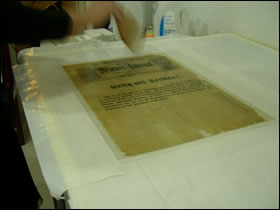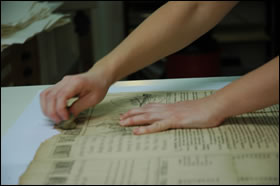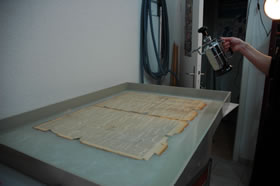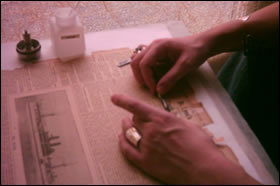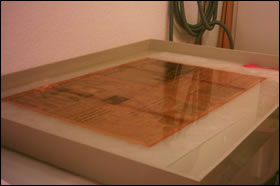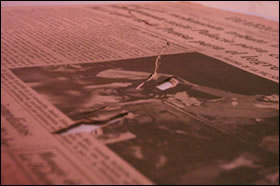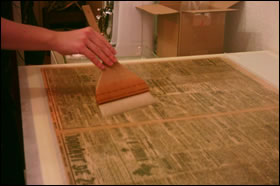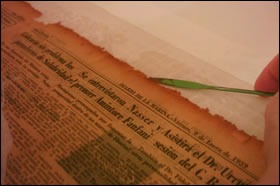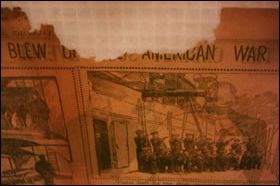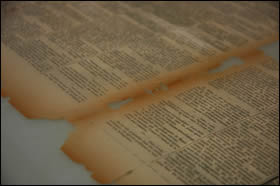
|
Conservation, restoration and exhibition of old newspapers: Newspapers are made with paper of very poor quality. The reason is simple: they are not supposed to last longer than one day. Because of that, newspapers are susceptible to discoloration and brittleness, due to the nature and the composition of the paper. High lignin content is a particular problem. Papers with high lignin content are very light sensitive, and light -- in particular sunlight -- is one of the three worst enemies of newspaper. The other enemies are heat and humidity. Some of the newspapers in this collection are more than 100 years old. It doesn't mean the older the paper, the worse the quality. In fact, the older the newspapers are, the better they keep because of the high quality paper used 200 or 300 years ago. Newspapers of late 19th and the 20th century -- the major part of papers in this collection -- can deteriorate very quickly. That's why, in the absence of a room with controlled temperature and humidity, one of the easiest way to preserve this collection is to avoid direct contact with sunlight, or light in general, and to treat newspapers with alkaline material in order to slow down acid hydrolysis. This and other chemical reactions are best avoided by not exposing the newspapers to atmospheric oxygen, which, combined with high sulphur bleach used in modern newsprint, produces quick corrosion of the cellulose fibres of which wood pulp paper is composed. But what to do with historical newspapers or newspapers of high value for other reasons (design, rarity, significance, etc) that are in advanced stage of deterioration, very fragile, and almost impossible to exhibit? Restoration and proper conservation is the answer. Common treatments for old newspapers include surface cleaning, to reduce superficial dirt accumulated through dust or humidity; washing, to reduce acidity, dirt and stains; alkalization (or de-acidification), to combat acid deterioration by neutralizing the acid present in papers; mending of tears; reinforcing brittle paper by backing it with Japanese paper; filling areas of paper loss; and removal of mould. Many historically valuable newspapers in this collection have been treated by the expert hands of two persons who devote their work to restoring and taking care of old documents with passion and dedication: Judith Emprechtinger, a conservationist at the Österreichischen Nationalbibliothek (Austrian National Library), in Vienna, and Charlotte Sauvin who has a workshop in Geneva called "Fibre o livre". The results of their work are incredible: newspapers that were on the verge of disintegration or were impossible to handle due to their brittleness came back to life and are now flexible, clean, readable, and ready to be preserved for future generations. This is how Judith Emprechtinger explains her work in preserving old newspapers: "I think really deteriorated paper can profit a lot from being washed. I usually wash paper in de-ionized calcium enriched water. After the washing (which can often consist of several baths) the newspaper can be re-immersed in an alkaline bath based on calcium or magnesium. Wet treatment removes acidic degradation components in the paper and to a certain degree can restore the flexibility of the fibres. The alkaline bath will neutralize the low pH of the paper and slow down acidic hydrolysis. Care needs to be taken not to raise the pH too high or too fast to prevent damage to the fibres. Tears and weak areas can be mended with Japanese paper and wheat starch paste. This will probably be enough for areas with folds, creases and tears. Newspapers that are very fragile will indeed need some support: basically there are two options : a Japanese paper support or a clear polyester housing. The third being splitting the newspaper and inserting Japanese paper which I do not really favour, because it really has a great impact on the original substance. There are very thin Japanese papers than can be applied with wheat starch paste to the entire page or parts of it. You will still be able to read the paper, however it will look a little bit like having a "veil". The other option is to house the paper between two sheets of clear polyester film that is sealed along two edges or if necessary along three edges. This so called L-sleeve is preferable to a complete encapsulation because the paper can still breathe a little bit. It is still advisable that the paper has been washed before inserting it in its housing. This is probably the best option because it means the least impact on the original and you can still see the paper without a "veil". But different newspapers call for different solutions, depending on their actual state of conservation". Baths? Immersions in an alkaline solution? De-acidification? Japanese paper support? Wheat starch paste?. Yes, all these seems a bit odd, but its part of the routine work for conservationist and restorers of newspaper. And to illustrate it, here are some pictures taken of the process of restoration of some newspapers in this collection at the workshop of Charlotte Sauvin. The steps she follows are mainly four: -- Bath of de-acidification; Exhibition Sometimes I ask myself, what is the point in keeping historic newspapers, restoring and preserving them, if they are kept out of public view? I like to re-read these newspapers now and then, look at the front pages, and reflect about their content. But I also want other people to see them, newspaper lovers, students of history or journalism, historians, and curious people in general. And in the past few years, national libraries, banks, universities, book fairs, science museums, newspaper foundations, cultural centres and others have hosted exhibitions of this collection in different formats. There are some important details that have to be considered for proper handling of old newspapers for exhibitions. These are some of them as applied in recent exhibitions:
|
